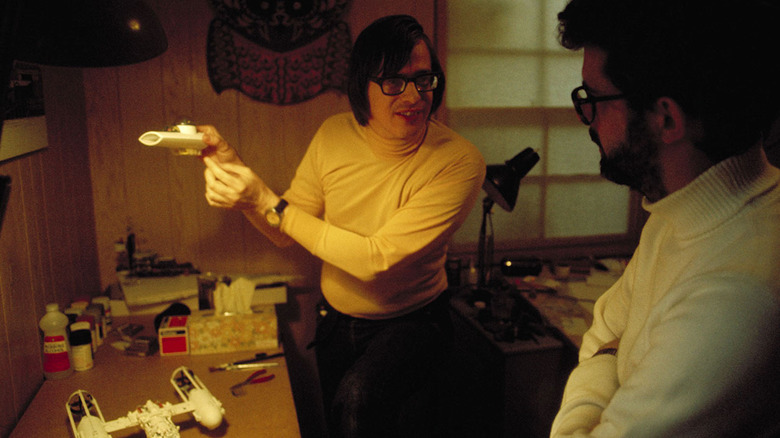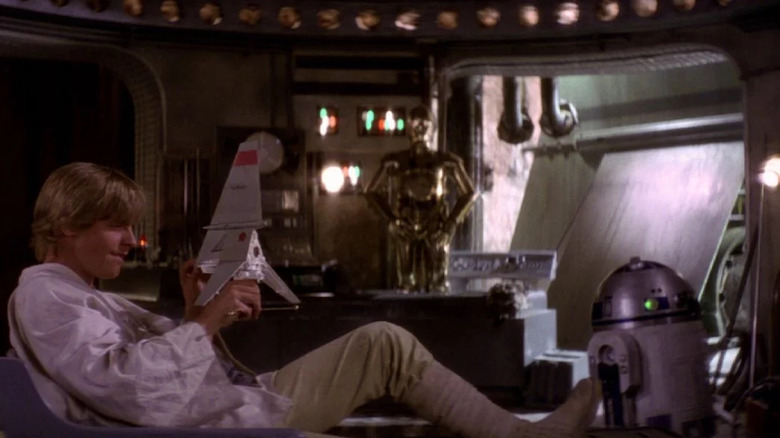Colin Cantwell, The Concept Artist Who Designed The Death Star, Dies At 90
The world has lost one of the minds behind the world of "Star Wars." Colin Cantwell, who played a significant role in the early days of filming "Star Wars," passed away in his Colorado home on Saturday, May 22, 2022 at the age of 90. The news was shared by his partner, Sierra Dall, who posted it on his Facebook page on Sunday.
When it comes to iconic, seminal films, there are few that can stand taller than the original 1977 "Star Wars." Yes, that sci-fi-meets-western story sprang from George Lucas' mind, and no one but him could have made that film — but he had a lot of help designing the world. You may not know the name Colin Cantwell, but you for sure know his work.
Cantwell was a former NASA employee who in the '70s transitioned into the wide world of Hollywood. According to his website, he used his knowledge of space to help movie directors create believable future and/or far-away worlds. He even worked on Stanley Kubrick's "2001: A Space Odyssey" before being chosen to help bring Lucas's ambitious sci-fi fantasy to life. Not only was Cantwell an influential contributor to designing "Star Wars," it's very likely he was one of the first people hired for the job back in November of 1974. A post at StarWars.com thinks it's likely that his hiring pre-dated that of concept artist Ralph McQuarrie.
It was crucial for someone of Cantwell's talent's to be brought onto "Star Wars" early on because this was when the visual look of Lucas's vast galaxy was being formed. Cantwell designed and executed prototypes for the X-Wing, the Y-Wing, the Death Star, the Star Destroyer, the TIE Fighter, Sandcrawler, and landspeeder. He even designed the T-16 skyhopper, which was intended for a lengthy race scene in "A New Hope" — but that had to be scrapped and Lucas would later repurpose that scene as the podrace sequence in "The Phantom Menace." Still, you can see Luke playing with a model of the T-16 that Cantwell created.
Functionality first and foremost helped create the Star Wars look.
According to the official Star Wars website, Ralph McQuarrie worked closely with Cantwell in the early days of Lucasfilm, basing many of his now-iconic concept paintings on designs and models created by Cantwell. Cantwell was credited with adding functionality to many of Lucas's wild ideas, giving the ships that grounded, lived in, real-world look that came to define the "Star Wars" aesthetic.
He wasn't content to just make the ships look cool, they had to be believable as real modes of transportation.
Cantwell's time at NASA was spent mostly at the Jet Propulsion Laboratory where he designed educational programs for the public during the heated Space Race of the late '60s. Incredibly, he found himself at the center of one of our nation's most historic moments as he was tasked to relay updates from NASA to news anchor Walter Cronkite, who famously covered the moon landing on live television and was reportedly watched by over 650 million people worldwide.
There are many parents when it comes to what ends up on-screen in the most legendary of influential films, and Cantwell's initial work for "Star Wars" was refined by folks like McQuarrie, Lucas himself, Phil Tippett and Joe Johnson, as well as a few dozen other geniuses that worked at Industrial Light & Magic and Lucasfilm at that time. Still, he was one of Star Wars' founding fathers regardless, and without him, that galaxy far, far away that we all love so much would look and feel pretty different.

